How to cook a turkey in a deep fat fryer: get maximum results for Thanksgiving and Christmas
Step-by-step instructions for how to use a turkey fryer, plus safety guidelines

If you’re planning to host for family or friends during the holiday season, you’ve likely already considered how to cook a turkey for Thanksgiving or Christmas.
Tradition calls for a roasted bird for the holiday festivities, but how about trying a new Cajun-inspired method to cook turkey and wow your guests?
Not only can a turkey fryer save you time and space in the kitchen to prepare all the trimmings on the big day, but a perfectly cooked deep-fried turkey is also absolutely delicious, with crispy, flavorful skin on the outside and succulent, tender meat within.
Your moreish and beautifully bronzed deep-fried turkey will be the centerpiece of your holiday table and the talk of your dinner guests, having them come back for seconds.
Beyond the yuletide season, your turkey fryer will become your best friend when it comes to deep-fat frying anything from potato fries to onion rings, calamari, or chicken; the world will be your oyster, which, incidentally, you can also have a go at deep-frying in breadcrumbs.
This best turkey fryer guide will give you our top picks for the holiday season, while the best deep fryers will see you through the rest of the year.
If you're looking for some inspiration on what to fry up next in your turkey fryer, check out these 9 foods to fry in a turkey fryer (that aren't turkey).
Sign up to receive the latest news, reviews, buying guides and deals direct to your inbox
How to cook a turkey in a deep fat fryer
- Turkey fryer (electric or propane) alternatively a 30-quart aluminum, or stainless steel fry pot for outdoor cooking
- Liquid propane gas tank (for propane fryers)
- Outdoor fry burner with control regulator hose (for propane fryers)
- Poultry fry lifter and rack (if not included with fryer)
- Peanut oil, or canola oil for frying
- Heat-resistant gloves
- Long-stem meat thermometer
- Roasting pan and rack
- Cutting board and carving knife
- Aluminium foil
- Long reach lighter
- Fire extinguisher
- timer (optional)
- Meat injecting syringe (optional)
- Butter (optional)
- Spice rub (optional)
Now for the main event; let’s get to the specifics. Turkey fryers are traditionally powered with propane gas and, therefore, require a safe outdoor cooking space, which we will get to. On the other hand, electric turkey fryers enable customers to cook indoors without using propane.
Both propane and electric turkey fryers will ensure your turkey is cooked significantly quicker than a traditional oven. It’s recommended that a turkey be cooked for between 3 and 4 minutes per pound. Therefore, a 12-pound turkey would require up to 48 minutes in the turkey fryer rather than hours in a conventional oven, which is an obvious benefit and time-saving hack you will be grateful for on the big day.
The process for cooking a turkey in a propane turkey fryer vs. an electric turkey fryer varies. To make it easier to navigate, we’ve broken down this step-by-step guide into two parts, including instructions for both turkey fryers.
If you already have your turkey fryer, simply navigate to the appropriate section to read the step-by-step guide. If you’ve yet to make a purchase, reading both sets of instructions may help to inform your choice between purchasing a propane or electric turkey fryer.

Pro Tips:
1. To completely drain excess moisture, place on an empty can, bottle or tube pan and refrigerate, uncovered, overnight.
2. A thawed turkey may be kept in the refrigerator (40 degrees F or below) up to 4 days before cooking.
3. There should be at least 3 to 5 inches from the fill line to the top of the pot so oil doesn’t boil over.
How to cook a turkey in a propane turkey fryer: quick steps
- Prepare your equipment and cooking space
- Prepare the turkey
- Heat the oil, and place the turkey in the fryer
- Fry the turkey, safely remove the turkey, and allow it to rest
- Turn off the heat, allow the oil to cool, and discard safely
How to cook a turkey in a propane turkey fryer: Step-by-step guide
1. Prepare your equipment and cooking space
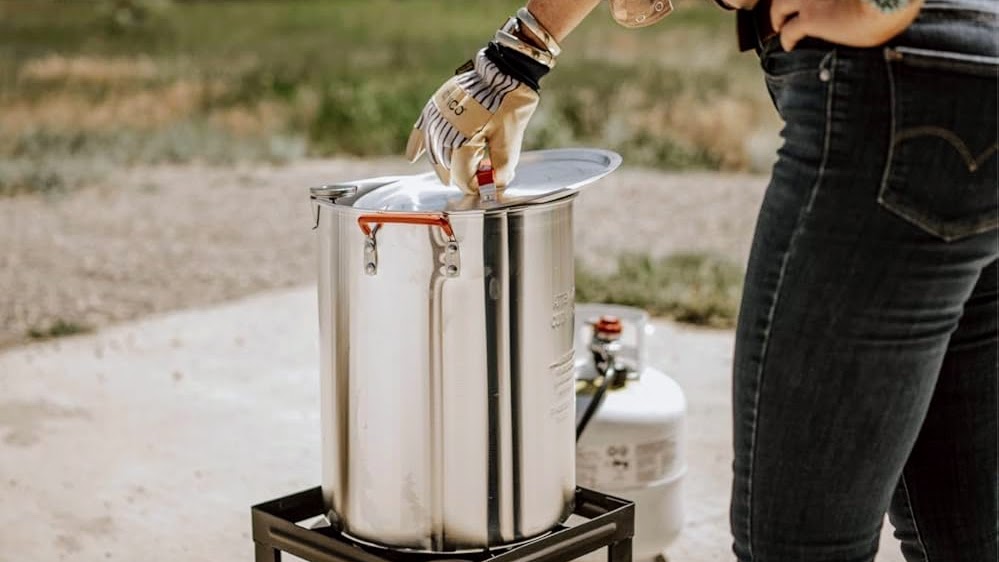
First, you must figure out where you will fry the turkey; propane turkey fryers are only suitable for outdoor use and only when the weather is dry. Therefore, you must have an open space with no overhead shelter, such as a garden patio, where you can set up your equipment. Be sure to place your fryer on a level and stable surface, at least ten feet from your dwelling.
Ensure that you are aware of the fire risks when cooking outdoors with propane gas and hot oil. Only adults wearing the appropriate heat-proof gloves should operate the turkey fryer.
While in use, be sure to keep children and animals at a safe distance from the turkey fryer, ideally in a separate room and at least 3 feet away. Never leave the turkey fryer unattended. In addition to the other equipment, have a fire extinguisher for grease with you.
Set up your propane gas tank, burner, and turkey fryer according to the manufacturer's instructions and safety guidelines. Some models don’t require oil and instead use infrared technology to fry the turkey; in that case, follow the manufacturer's instructions directly.
You will need to work out how much oil is required to fry the turkey to ensure there isn’t excess oil and spillover when the turkey is lowered into the hot oil.
Unless your turkey fryer has a maximum oil guideline, placing your turkey in an airtight and watertight ziplock bag is the best way to work this out. Fill your turkey fryer pot with water and put it in to ensure it covers the turkey but doesn’t spill over the sides.
Remove the turkey from the fryer and mark or measure the point at which the water levels out. Note this, as this will be the measure for your oil when frying your turkey. Empty the water from the pot and ensure it’s completely dry before proceeding. Remove the turkey from the zip-lock bag and pat it down to ensure that it’s completely dry.
2. Prepare the turkey
Many recipes online recommend injecting flavored butter into the turkey meat and coating the skin with a spice rub prior to frying. For safety, it’s vitally important to ensure that the turkey is fully defrosted and completely dry before you fry it. You will want to do this before you baste the turkey with butter and chosen spice rubs, if using.
You can find many recipes online for butter and spice rubs to prepare your turkey ahead of the frying process. Once you have injected the meat in all areas with the butter and applied the rub according to the recipe, if using, the turkey is ready for the fryer.
We love the recipe from Ohsodelicioso here.
3. Heat the oil, and place the turkey in the fryer
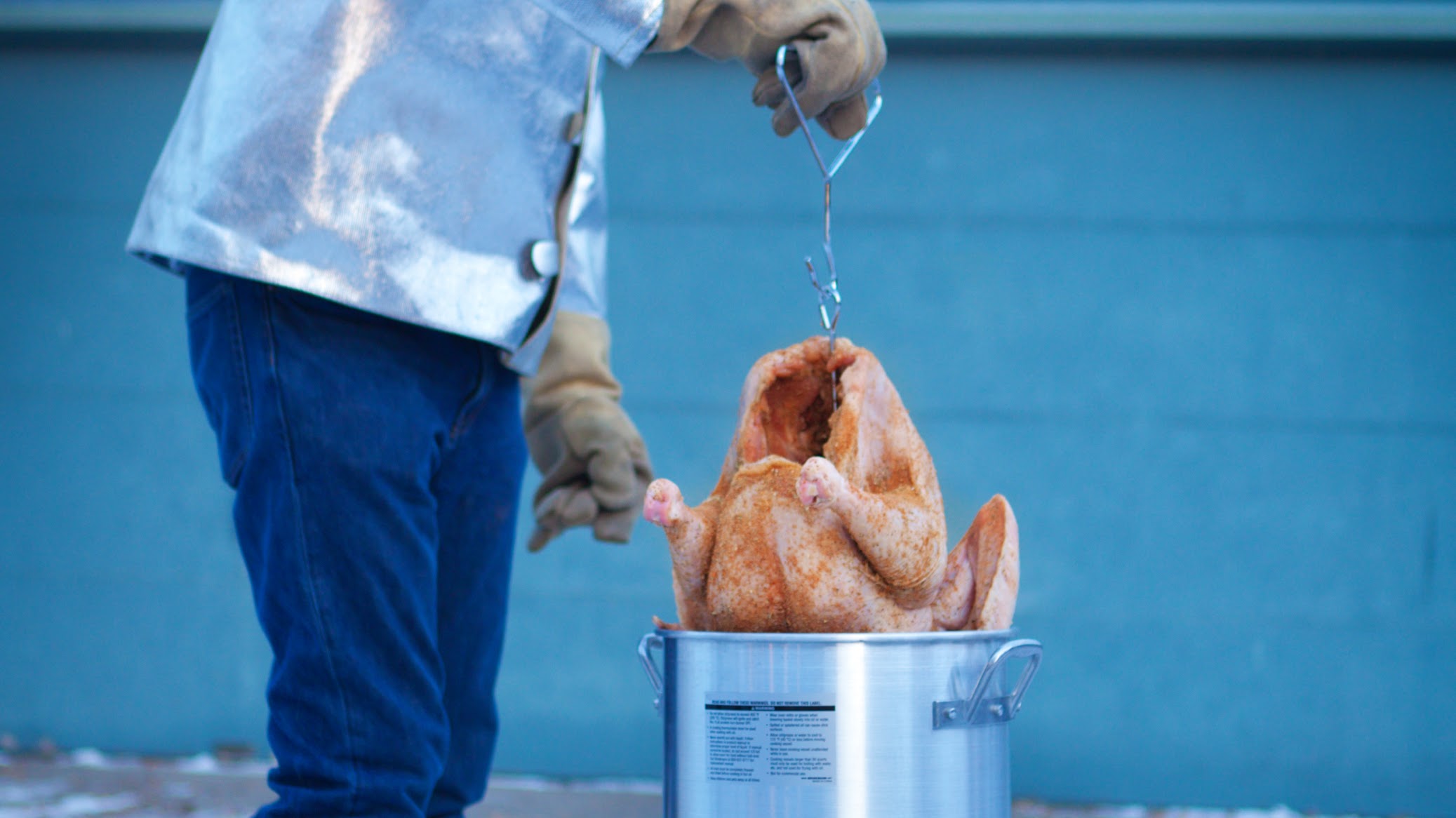
Wearing heat-resistant gloves, fill the pot with oil to the pre-measured point. Peanut oil is a popular oil for deep-frying turkeys because it has a high smoking point. You may also opt for canola oil.
Heat your oil to 275 degrees, at which point you may place the turkey in the basket or rack. Using the hook and lowering device, very gradually and slowly lower the turkey into the oil, taking time to allow the hot oil to accommodate it.
The oil will naturally splutter and rise, so this is the point at which to be highly cautious about overflow and spillage. Adjust the oil temperature to 325 degrees Fahrenheit, and fry the turkey at this temperature, according to the weight of the bird (3 - 4 minutes per pound). You may wish to set a timer for the appropriate cooking time for the turkey.
4. Fry the turkey, safely remove the turkey, and allow it to rest
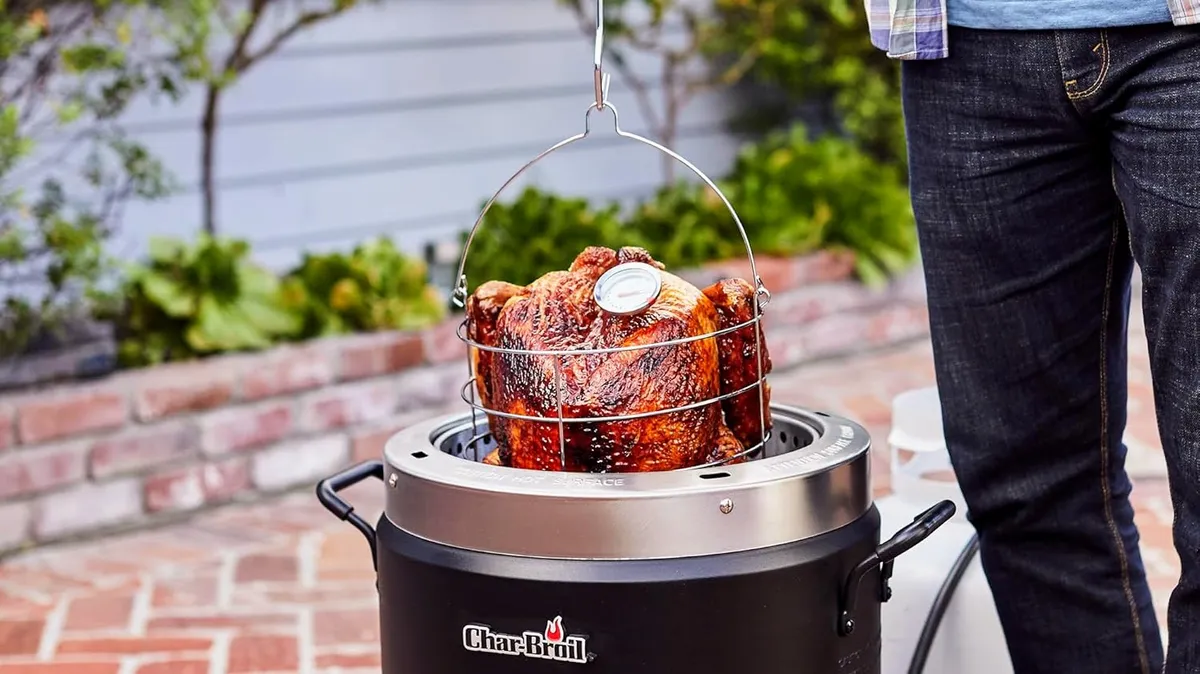
Accompany the turkey throughout the frying, and once the time is up, check the temperature of the thickest parts of the turkey using the meat thermometer. Ensure the internal temperature of the turkey is 165 degrees Fahrenheit.
Once the turkey is cooked fully, slowly and carefully remove it from the oil with the lowering hook and allow the oil to drain as much as possible before transferring it to a cooling rack in a roasting pan. Cover the turkey in aluminum foil and allow it to rest for thirty minutes prior to carving.
5. Turn off the heat, allow the oil to cool, and discard safely

Switch off the burner to remove the heat source, cover the pot, and allow the oil to cool safely, which may take an hour or two. To dispose of the oil safely and sustainably, it’s best to allow it to cool fully, transfer it to a large sealed container, refrigerate or freeze until solid, and then dispose of it in your trash bin.

If you are not confident in your turkey frying abilities, I assure you that YOU CAN DO IT. This recipe is simple, but you must follow the directions. The instructions will keep you safe and your bird cooked perfectly.
Frying a turkey is not a process where you want to take personal liberties with the recipe. Just stick to the directions, and you’ll pull it off like a pro. Make sure you pay attention to the details, like testing the fill line, making sure there is no water in the bird, and keeping the oil from getting too hot. We can’t wait for you to have the best turkey of your life!
How to cook a turkey in a electric turkey fryer: quick steps
- Prepare your equipment and cooking space
- Prepare the turkey
- Heat the oil, and place the turkey in the fryer
- Fry the turkey, safely remove the turkey, and allow it to rest
- Turn off the heat, allow the oil to cool, and discard safely
How to cook a turkey in a electric turkey fryer: Step-by-step guide
1. Prepare your equipment and cooking space
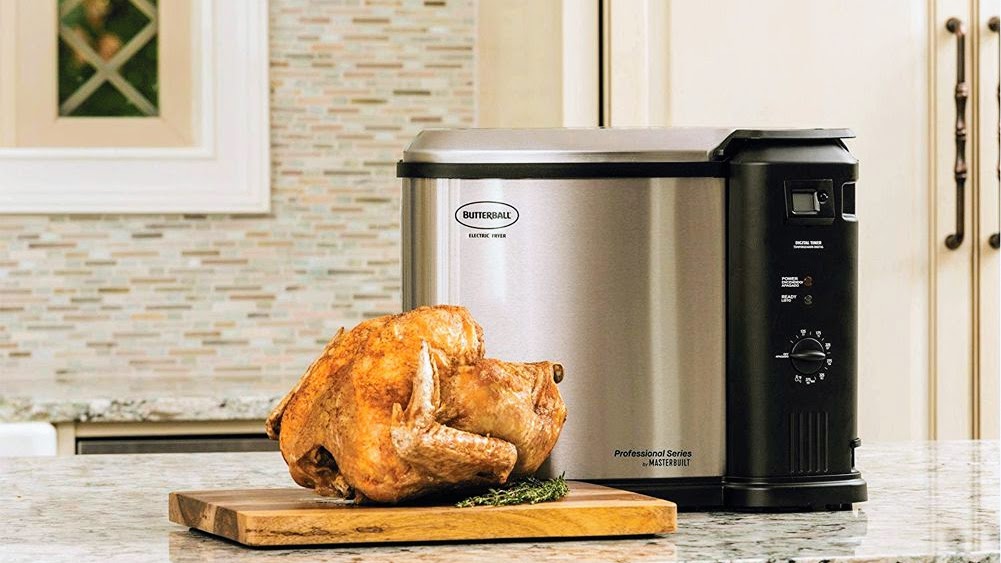
With an electric deep fryer, you will need a space to prepare and fry the turkey indoors, ensuring safety at all times with hot oil and electricity. Be sure to place your fryer on a level and stable surface. You don’t need to worry about the weather or preparing a burner or propane gas tank, so all you need are the tools to prepare, rest, and serve your turkey, plus the electric turkey fryer, with the lowering hook and basket and safety equipment such as gloves and a fire extinguisher.
Again, you will need to ensure that only adults wearing the appropriate heat-proof gloves operate the turkey fryer. Be sure to keep children and animals at a safe distance, ideally in another room entirely but at least three feet away from it while in use. Ensure that someone is attending to the fryer at all times. Again, have a fire extinguisher to hand with you and the other equipment.
Set up your electric turkey fryer according to the manufacturer's instructions and safety guidelines before use.
An electric turkey fryer should have a maximum oil guideline within, so you may simply pour in enough oil to cover the turkey up to the line with no safety concerns about spillage. Electric fryers also all come with lids, which some propane turkey frying pots don’t, an added safety benefit.
2. Prepare the turkey
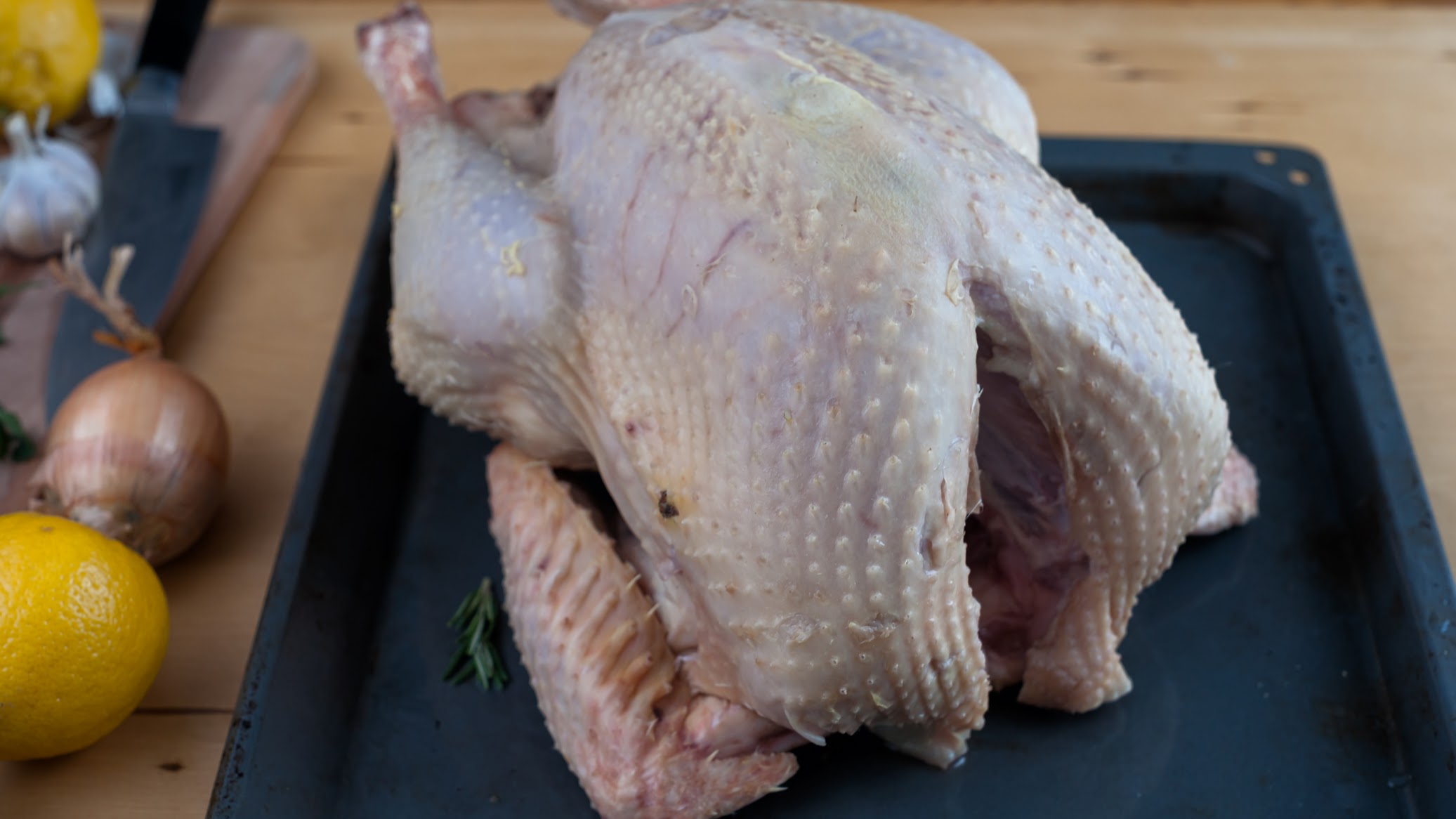
Many recipes online recommend injecting flavored butter into the turkey meat and coating the skin with a spice rub prior to frying. For safety, it’s vitally important to ensure that the turkey is fully defrosted and completely dry before you fry it. If using, you will want to do this before you baste the turkey with butter and chosen spice rubs.
You can find many recipes online for butter and spice rubs to prepare your turkey ahead of the frying process. Once you have injected the meat in all areas with the butter and applied the rub according to the recipe, if using, the turkey is ready for the fryer.
3. Heat the oil, and place the turkey in the fryer
Wearing your heat-resistant gloves, fill the pot with the oil to the pre-measured point. Peanut oil is popular for deep-frying turkeys because it has a high-smoking point. You may also opt for canola oil. Heat your oil to 275 degrees, at which point you may place the turkey in the basket or rack, and using the hook and lowering device, slowly lower the turkey into the oil, taking time to allow the hot oil to accommodate the turkey. Adjust the oil temperature up to 325 degrees Fahrenheit, and fry the turkey at this temperature, according to the bird's weight (3 - 4 minutes per pound). You may wish to set a timer for the appropriate cooking time for the turkey.
4. Fry the turkey, safely remove the turkey, and allow it to rest
Accompany the turkey throughout the frying, and once the time is up, check the temperature of the thickest parts of the turkey using the meat thermometer. Ensure the internal temperature of the turkey is 165 degrees Fahrenheit.
Once the turkey is cooked fully, slowly and carefully remove it from the oil with the lowering hook and allow the oil to drain as much as possible before transferring it to a cooling rack in a roasting pan. Cover the turkey in aluminum foil and allow it to rest for thirty minutes prior to carving.
5. Turn off the heat, allow the oil to cool, and discard safely

Turn off the electric turkey fryer, cover, and allow the oil to cool safely, which may take an hour or two. To dispose of the oil safely and sustainably, it’s best to allow it to cool fully, transfer it to a large sealed container, refrigerate or freeze until solid, and then dispose of it in your trash bin.
How to cook a turkey in a deep fryer: FAQs
How do I ensure safety when frying a turkey with a deep fryer?
Here are some key safety guidelines:
1. Never use an outdoor fryer in wet weather (snow or rain)
2. Always keep a fire extinguisher for grease nearby
3. Don’t ever use water to attempt to put out a fire caused by oil
4. Always wear protective gloves, oven mitts, and goggles
5. Never leave your fryer unattended while in use
6. Be sure to place your fryer on a level and stable surface, at a minimum of ten feet from your dwelling
7. Keep children and animals in another room, ideally, and at least three feet away from the fryer
Fried Turkey Recipe by Butterball
Brined Brown Sugar Deep Fried Turkey by Butterball
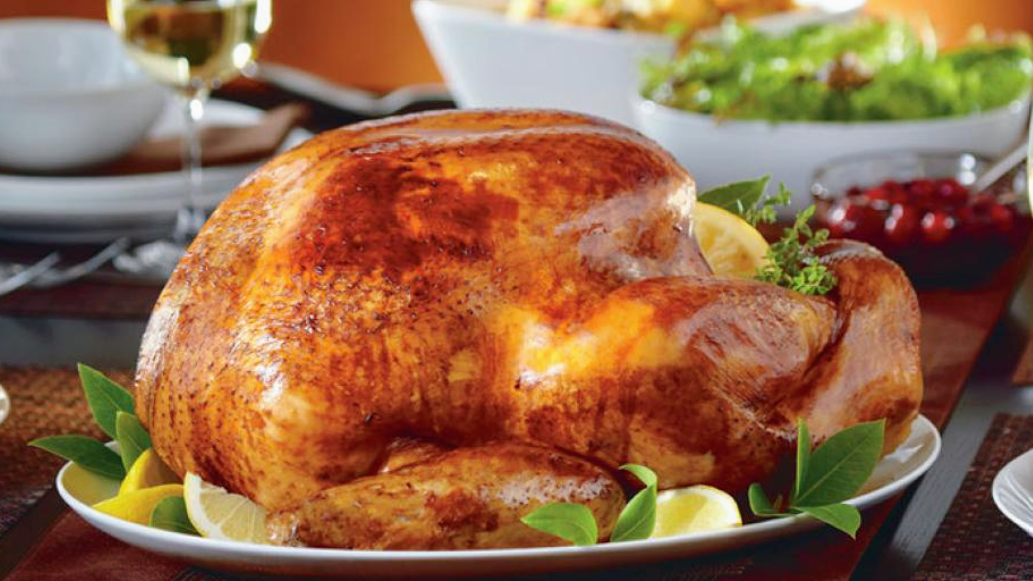
3 cups firmly packed brown sugar1-½ tablespoons mustard
¼ cup salt
2 tablespoons cayenne pepper
2 gallons cold water
1 bunch fresh thyme
1 head garlic, separated into cloves and crushed
3 gallons peanut oil for frying
1 (10 - 12 pounds) BUTTERBALL® Whole Turkey, thawed if frozen
Directions:
Combine brown sugar, mustard, salt, and cayenne pepper in a large, non-metallic container. Gradually whisk in the water, thyme, and garlic.
Remove giblets and neck from turkey. Discard or refrigerate for another use. You can use the turkey lifter while in the brine mixture only. (Do not use it in the fryer.)
Place turkey in the brine mixture. Cover and refrigerate overnight.
Preheat oil to 400°F.
Pat the turkey dry with paper towels. Place the turkey, breast side up, in a basket. Slowly lower the basket into hot oil, being cautious of splattering oil.
Maintain oil temperature at about 350°F. Fry turkey for 3½ to 4 minutes per pound. Remove from oil to check doneness. Insert an instant-read thermometer into the thickest part of the breast, not touching the bone.
The temperature should read 170°F. Insert the thermometer into the thickest part of the thigh, not touching the bone. The temperature should be 180°F.
Remove turkey from hot oil and drain on paper towels. Let rest for 15 minutes before carving.
If you’ve read this far, perhaps you’ve been convinced that a deep-fried turkey will be the spectacular showstopping dish for your holiday meal or family gathering this year. With a beautifully burnished glow, crispy, flavorful skin, and juicy meat within, a delicious Cajun-inspired fried turkey will definitely impress your guests and save you some precious time to spend celebrating the occasion with your friends and family.
Whether you opt for a traditional propane fryer or an electric fryer for indoor use, this step-by-step guide provides essential instructions, safety guidelines, and recipe ideas for successfully frying your turkey.

Emily joined the team as a Homes Editor at Top Ten Reviews in 2024. With 15 years of experience copywriting and editing content for printed and digital media platforms across publishing, e-commerce, and social media, Emily specializes in writing about home, lifestyle, and health. Having worked for publications and brands including Harper’s Bazaar, Cosmopolitan, House of Fraser, National Trust, and more, Emily is passionate about pursuing many sources of inspiration. She lives with her husband, two children, pug Coco, cat Smokey, and three Guinea Pigs in Devon, England. Other than spending time in the great outdoors with the family, she loves nothing more than finding a great discount on a high-ticket product.
